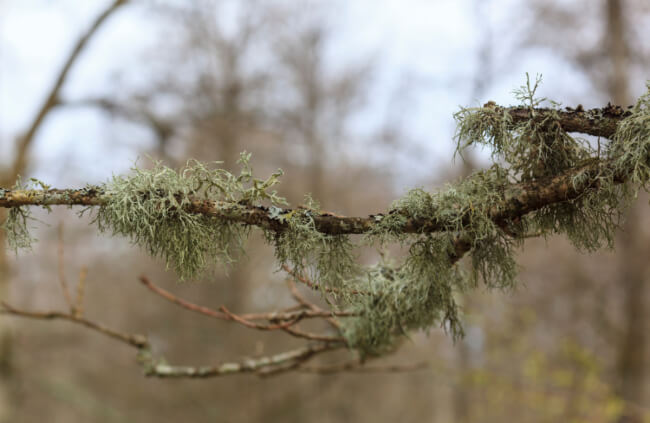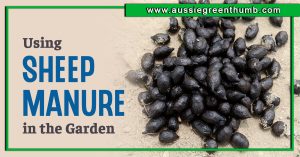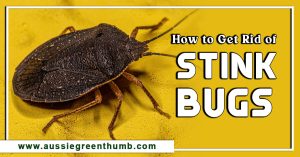If there is one thing that screams “I’m old” in the garden it’s the addition of lichens. Growing on walls, tree trunks and even along paths, lichen can age a garden quite dramatically regardless of its true measure.
More...
What are Lichens?

Lichens are a type of fungi that survive on air rather than being a parasite of their host. In fact, if lichens are growing in your garden it’s a good sign that the air quality of their environment is good.
Lichens don’t grow roots and they have no need to contain reservoirs of water. They just willingly spread themselves across their host and wait for moisture to present itself. And they won’t hurt their host either. Most lichens just attach themselves and then continue to grow.
There are various types of lichens based on their growth forms and morphological characteristics. Here are some common types of lichens:
- Crustose Lichens: These lichens have a crust-like growth form and tightly adhere to the substrate, such as rocks, tree bark, or soil. They form a thin, tightly attached layer and often have a smooth or wrinkled appearance.
- Foliose Lichens: These lichens have a leaf-like or lobed structure with distinct upper and lower surfaces. They are loosely attached to the substrate by rhizines (root-like structures) and can be easily detached. The upper surface is usually smooth or textured, while the lower surface is typically lighter in color.
- Fruticose Lichens: These lichens have a shrubby or bush-like growth form. They are often attached at a single point and have branching structures. Fruticose lichens can be erect or pendulous, and they vary in size and complexity.
- Squamulose Lichens: These lichens consist of small, scale-like structures called squamules. These squamules are loosely attached to the substrate and can be easily detached. They can form a crust-like or slightly raised structure.
- Gelatinous Lichens: These lichens have a gelatinous or jelly-like appearance. They are often found in damp habitats and can be foliose or fruticose in form. The gelatinous texture helps them retain moisture.
- Filamentous Lichens: These lichens have a filamentous or string-like growth form. They consist of interwoven or tufted filaments and are commonly found in aquatic or moist environments.
- Leprose Lichens: These lichens are powdery or granular in texture. They form a crust-like layer composed of small particles or granules. These lichens can be easily dispersed by wind or other disturbances.
It's important to note that lichens exhibit a wide range of colors, including green, gray, yellow, orange, brown, and black. The specific species within each lichen type can vary significantly in terms of their appearance, growth habits, and ecological preferences.
How to Grow Lichens in Australia
For those of us who appreciate lichens and relish the idea of being able to make our gardens look older than they are, growing lichens is quite easy. Firstly, make sure the location of your desired lichens is not in full sun.
Most lichens appreciate, or at least tolerate, dappled shade but rarely do they survive in full sun unless it's a really cold climate. Second, paint the area you wish to have lichen growing with a liquid seaweed fertiliser.
Another option is to use a spray bottle and mix equal parts yoghurt and water. Then spray the area quite liberally. If this doesn’t work immediately, repeat the procedure until it does.
Summer is probably the only season which is not suitable for trying this process but the other nine months are quite accommodating.

How to Remove Lichens
Some gardeners can’t tolerate lichens growing in their gardens and will treat these fungi with fungicides and sprays attempting to rid them. However, the best way for removing lichens from a tree or a wall is to use a light scrubbing brush and warm water.
If you are growing ornamental trees for their bark you may find that the lichen detracts from this feature so removing it might be the best option.
Wrapping Up Our Lichens Growing Guide
Growing lichens in your garden can have a positive effect, predominantly ageing it and adding another level of interest for your visitors. They’re also a cheap gauge for what the air quality is like in your backyard.
Published on May 28, 2023 by Gary Clarke
Last Updated on January 27, 2024





Gary, it’s been a while since my last visit, and what a feast. First the lichen info, which I will try on some rocks when summer is finished. Then that nifty little slideshow of your home garden update. Good that it’s nice and compact. And then I enjoyed your spam rant – I didn’t realise you could be a ranter!
Hello Val. You’ve been sorely missed. I have been keeping up with your blog via RSS but have had little time to comment so appreciate you stopping in.
Oh, yes. I can rant. It does take a lot to fire me up but when I get going it takes a lot to stop me as well.
Awesome about Pratt hey? Are you happy he’s been selected?
Hi, I’m from Flagstaff Arizona, USA.
My father and I have been trying to grow lichen on rocks for a while, I found this sight and it helped a lot.
Before I tried it I had a few questions, first, since I live in a moderately hot area, will the lichen still grow? How long will this take to grow? Which kind of lichen will grow from this? And can I vary the color of which the lichen grows?
If you can answer these things it would help…So much.
Thanks.
Adrian,
I had lived in your area for a few years and heat should not be a problem. I consider Flagstaff as too cold for me:) Anyways, at the Grand Canyon I would often see lichens on rocks and even small beard lichen (Usnea arizonica?) on the Pinon Pine. If you love lichen I suggest you take a hike up “Red Butte” located between Valle and Tusayan, AZ. There are lichens everywhere but it’s the fluorescent yellow/green lichens on red rocks that are my favorite. Easy climb and great view too.
hi
I am trying to grow ichens on fabric. Is there any way that this will work?
What about rockwool? could I paint it with equal parts of water and yoghurt and would it grow? What about some kind of non porous plastic??
Hi, i really like lichens so I’d like to correct a few of the errors contained in your article. Firstly lichens aren’t moss, nor are they at all closely related to moss. As a matter of fact they aren’t a single species but a partnership between two different species from different branches of the tree of life (neither of which are closely related to mosses).
One component of this amazing partnership is a fungus which attaches to the tree, rock, or whatever the lichen is growing on and provides shelter from the harsh elements. The other partner is an algae which photosynthesises and feeds both itself and the fungus. Many species of fungi and algae can form these partnerships, giving the vast array of different lichens we see.
Also, it’s not true to say that lichens cause no damage. In fact the fungal hyphae (root-like structures) can penetrate rock and can also exude acids that also cause damage. This can result in damage to painted surfaces and pitting of rocks and wood, although they don’t harm trees. This is really only a problem on painted surfaces.
I hope you will consider altering your article in light of this information as I think it’s really a fascinating example of different organisms working together. Thanks – Sam